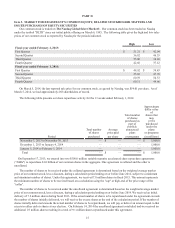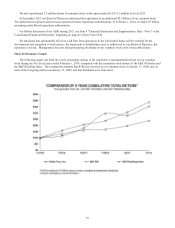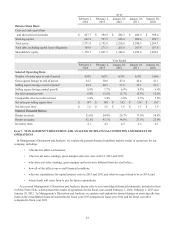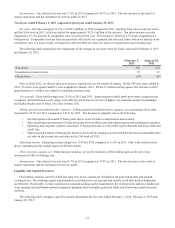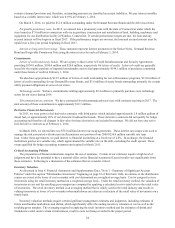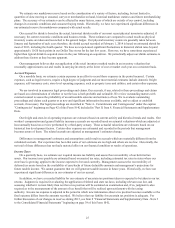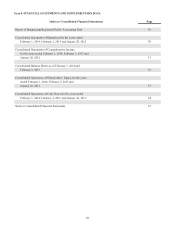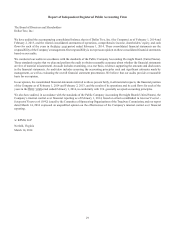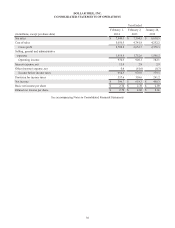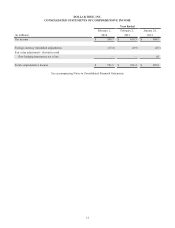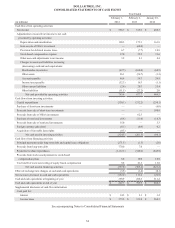Dollar Tree 2013 Annual Report Download - page 41
Download and view the complete annual report
Please find page 41 of the 2013 Dollar Tree annual report below. You can navigate through the pages in the report by either clicking on the pages listed below, or by using the keyword search tool below to find specific information within the annual report.25
We estimate our markdown reserve based on the consideration of a variety of factors, including, but not limited to,
quantities of slow moving or seasonal, carryover merchandise on hand, historical markdown statistics and future merchandising
plans. The accuracy of our estimates can be affected by many factors, some of which are outside of our control, including
changes in economic conditions and consumer buying trends. Historically, we have not experienced significant differences in
our estimated reserve for markdowns compared with actual results.
Our accrual for shrink is based on the actual, historical shrink results of our most recent physical inventories adjusted, if
necessary, for current economic conditions and business trends. These estimates are compared to actual results as physical
inventory counts are taken and reconciled to the general ledger. Our physical inventory counts are generally taken between
January and September of each year; therefore, the shrink accrual recorded at February 1, 2014 is based on estimated shrink for
most of 2013, including the fourth quarter. We have not experienced significant fluctuations in historical shrink rates beyond
approximately 10-20 basis points in our Dollar Tree stores for the last few years. However, we have sometimes experienced
higher than typical shrink in acquired stores in the year following an acquisition. We periodically adjust our shrink estimates to
address these factors as they become apparent.
Our management believes that our application of the retail inventory method results in an inventory valuation that
reasonably approximates cost and results in carrying inventory at the lower of cost or market each year on a consistent basis.
Accrued Expenses
On a monthly basis, we estimate certain expenses in an effort to record those expenses in the period incurred. Certain
expenses, such as legal reserves, require a high degree of judgment and our most material estimates include domestic freight
expenses, self-insurance costs, store-level operating expenses, such as property taxes and utilities, and certain other expenses.
We are involved in numerous legal proceedings and claims. Our accruals, if any, related to these proceedings and claims
are based on a determination of whether or not the loss is both probable and estimable. We review outstanding matters with
external counsel to assess the probability of an unfavorable outcome and estimates of loss. We re-evaluate outstanding
proceedings and claims each quarter or as new and significant information becomes available, and we adjust or establish
accruals, if necessary. Our legal proceedings are described in "Note 4 - Commitments and Contingencies" under the caption
"Contingencies" beginning on Page 42 of this Form 10-K included in "Part II. Item 8. Financial Statements and Supplementary
Data.
Our freight and store-level operating expenses are estimated based on current activity and historical trends and results. Our
workers' compensation and general liability insurance accruals are recorded based on actuarial valuations which are adjusted at
least annually based on a review performed by a third-party actuary. These actuarial valuations are estimates based on our
historical loss development factors. Certain other expenses are estimated and recorded in the periods that management
becomes aware of them. The related accruals are adjusted as management’s estimates change.
Differences in management's estimates and assumptions could result in accruals which are materially different from the
calculated accruals. Our experience has been that some of our estimates are too high and others are too low. Historically, the
net total of these differences has not had a material effect on our financial condition or results of operations.
Income Taxes
On a quarterly basis, we estimate our required income tax liability and assess the recoverability of our deferred tax
assets. Our income taxes payable are estimated based on enacted tax rates, including estimated tax rates in states where our
store base is growing, applied to the income expected to be taxed currently. Management assesses the recoverability of
deferred tax assets based on the availability of carrybacks of future deductible amounts and management’s projections for
future taxable income. We cannot guarantee that we will generate taxable income in future years. Historically, we have not
experienced significant differences in our estimates of our tax accrual.
In addition, we have a recorded liability for our estimate of uncertain tax positions taken or expected to be taken in our tax
returns. Judgment is required in evaluating the application of federal and state tax laws, including relevant case law, and
assessing whether it is more likely than not that a tax position will be sustained on examination and, if so, judgment is also
required as to the measurement of the amount of tax benefit that will be realized upon settlement with the taxing
authority. Income tax expense is adjusted in the period in which new information about a tax position becomes available or the
final outcome differs from the amounts recorded. We believe that our liability for uncertain tax positions is adequate. For
further discussion of our changes in reserves during 2013, see Item 8 “Financial Statements and Supplementary Data - Note 3
to the Consolidated Financial Statements” beginning on page 39 of this Form 10-K.


